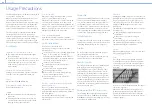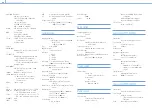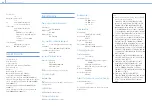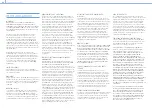
000
127
11. Appendix
Usage Precautions
The fan and battery are consumable parts that will
need periodic replacement.
When operating at room temperature, a normal
replacement cycle will be about 5 years.
However, this replacement cycle represents only
a general guideline and does not imply that the
life expectancy of these parts is guaranteed. For
details on parts replacement, contact your dealer.
The life expectancy of the AC adaptor and the
electrolytic capacitor is about 5 years under
normal operating temperatures and normal usage
(8 hours per day; 25 days per month). If usage
exceeds the above normal usage frequency, the
life expectancy may be reduced correspondingly.
Use and storage
Do not subject the camcorder to severe shocks
ˎ
ˎ
The internal mechanism may be damaged or
the body warped.
ˎ
ˎ
If an accessory mounted on the accessory shoe
is subjected to severe shock, the accessory shoe
may be damaged. In such a case, stop using
it and contact your dealer or a Sony service
representative.
Do not cover the camcorder while operating
Putting a cloth, for example, over the camcorder
can cause excessive internal heat build-up.
After use
Always turn off the POWER switch.
Before storing the camcorder for a long period
Remove the battery pack.
Shipping
ˎ
ˎ
Remove the media before transporting the
camcorder.
ˎ
ˎ
If sending the camcorder by truck, ship, air,
or other transportation service, pack it in the
shipping carton of the camcorder.
Care of the camcorder
Remove dust and dirt from the surfaces of the
lenses or optical filters using a blower.
If the body of the camcorder is dirty, clean it with
a soft, dry cloth. In extreme cases, use a cloth
moistened in a little neutral detergent, then wipe
dry. Do not use organic solvents such as alcohol or
thinners, as these may cause discoloration or other
damage to the finish of the camcorder.
In the event of operating problems
If you should experience problems with the
camcorder, contact a Sony service representative.
Use and storage locations
Store in a level, ventilated place.
Avoid using or storing the camcorder in the
following places.
ˎ
ˎ
In excessive heat or cold (operating temperature
range: –5 °C to +40 °C (23 °F to 104 °F))
Remember that in summer in warm climates
the temperature inside a car with the windows
closed can easily exceed 50 °C (122 °F).
ˎ
ˎ
In damp or dusty locations
ˎ
ˎ
Locations where the camcorder may be
exposed to rain
ˎ
ˎ
Locations subject to violent vibration
ˎ
ˎ
Near strong magnetic fields
ˎ
ˎ
Close to radio or TV transmitters producing
strong electromagnetic fields.
ˎ
ˎ
In direct sunlight or close to heaters for
extended periods
To prevent electromagnetic interference from portable
communications devices
The use of portable telephones and other
communications devices near this camcorder can
result in malfunction and interference with audio
and video signals.
It is recommended that the portable
communications devices near this camcorder be
powered off.
Condensation
If the unit is suddenly taken from a cold to a warm
location, or if ambient temperature suddenly
rises, moisture may form on the outer surface of
the unit and/or inside of the unit. This is known
as condensation. If condensation occurs, turn off
the unit and wait until the condensation clears
before operating the unit. Operating the unit while
condensation is present may damage the unit.
Fitting the zoom lens
It is important to fit the lens correctly, as otherwise
damage may result. Be sure to refer to the section
“Mounting and Adjusting the Lens” (page 25).
Viewfinder
Do not leave the camcorder with the eyepiece
lens pointing directly at the sun.
The eyepiece lens can concentrate the sun’s rays
and melt the interior of the viewfinder.
About the LCD panels
The LCD panel fitted to this unit is manufactured
with high precision technology, giving a
functioning pixel ratio of at least 99.99%. Thus a
very small proportion of pixels may be “stuck”,
either always off (black), always on (red, green, or
blue), or flashing. In addition, over a long period
of use, because of the physical characteristics of
the liquid crystal display, such “stuck” pixels may
appear spontaneously. These problems are not a
malfunction. Note that any such problems have no
effect on recorded data.
Phenomena specific to CMOS image sensors
The following phenomena that may appear in
images are specific to CMOS (Complementary
Metal Oxide Semiconductor) image sensors. They
do not indicate malfunctions.
White flecks
Although the CMOS image sensors are produced
with high-precision technologies, fine white flecks
may be generated on the screen in rare cases,
caused by cosmic rays, etc. This is related to the
principle of CMOS image sensors and is not a
malfunction.
The white flecks especially tend to be seen in the
following cases:
ˎ
ˎ
when operating at a high environmental
temperature
ˎ
ˎ
when you have raised the master gain
(sensitivity)
ˎ
ˎ
when operating in Slow-Shutter mode
The problem may be alleviated by executing
automatic black balance adjustment.
Aliasing
When fine patterns, stripes, or lines are shot, they
may appear jagged or flicker.
Flicker
If recording is made under lighting produced
by discharge tubes, such as fluorescent, sodium,
or mercury-vapor lamps, the screen may flicker,
colors may vary, or horizontal stripes may appear
distorted.
In such cases, set the flicker-reduction function to
auto mode (page 101).
If the frame rate selected for recording is close
to the power-supply frequency, flicker may not
be reduced sufficiently even if you activate the
Flicker-Reduction function. In such cases, use the
electronic shutter.









































